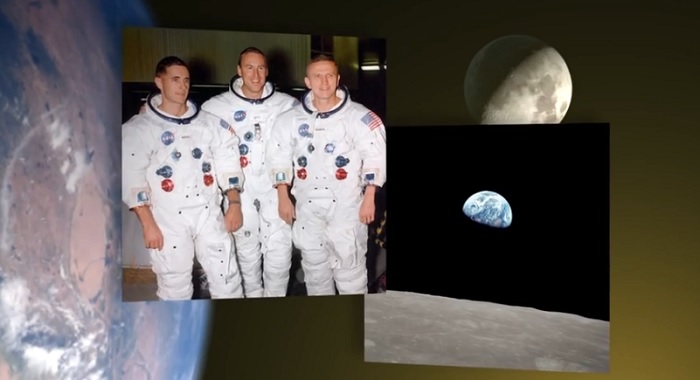.

NASA has issued a new visualization of the events leading to one of the iconic photographs of the 20th Century – Earth rising over the moon captured by the crew of the Apollo 8 mission.









The photo known as Earthrise is the first color photograph of Earth taken by a person in lunar orbit. Earthrise is the cover photo of TIME's Great Images of the 20th Century, and is the central photo on the cover of LIFE's 100 Photographs That Changed the World.
"Earthrise had a profound impact on our attitudes toward our home planet, quickly becoming an icon of the environmental movement," says Ernie Wright, project lead with the Scientific Visualization Studio at NASA's Goddard Space Flight Center in Greenbelt, Md.
The visualization clearly shows how Apollo 8 Commander Frank Borman and crew members William A. Anders and James A. Lovell worked together to photograph the stunning scene as their spacecraft orbited the moon on December 24, 1968. The video allows anyone to virtually ride with the astronauts and experience the awe they felt at the vista in front of them.



The new computer-generated visualization was created using data from NASA's Lunar Reconnaissance Orbiter (LRO) spacecraft and includes more details than the previous visualization.
"The Earthrise visualization that we released for Earth Day last year really only scratched the surface," says Wright. "The new visualization tells us not only what time the photos were taken, but also exactly which way the spacecraft was pointing and therefore which window each photo was taken from. This will also be the first time we've released a video that's synchronized with the onboard audio recording of the astronauts."
Earlier 'Earthrise' Photo Sent Back to the Moon by Laser
Along with this new visualization comes news that the first ever "Earthrise" photo, taken by NASA's Lunar Orbiter 1 in 1966 and restored and enhanced by the Lunar Orbiter Image Recovery Project in 2008, has been sent back to the moon. The historic image from Aug. 23, 1966 was sent as a full-resolution 700 Mb data file to NASA's Lunar Atmosphere and Dust Environment Explorer (LADEE) mission in lunar orbit, using the new Lunar Laser Communication Demonstration system. The new technology allowed the image to be sent to and from the moon in a fraction of the time required to originally send it back to Earth in 1966.
Matching Apollo Photos to LRO Data
Data from LRO was essential to recreate the Apollo 8 event accurately. "Matching Apollo photography to the lunar terrain required an accuracy and completeness that I think only LRO's data could provide," said Wright. "I worked at a level of detail that required 100-meter resolution with perfect registration. You gain a new appreciation for the care of the LRO scientists who create this data when you get your virtual camera set up and the overlaid Apollo photography just snaps into place."
"The key to the new work is a set of vertical stereo photographs taken by Apollo 8," adds Wright. "A camera was mounted in the rendezvous window that pointed straight down onto the lunar surface. It took a picture every 20 seconds. When the spacecraft rotated, so did the images. By registering each photo to a model of the terrain from LRO data, we can nail down the timing of the spacecraft's rotation."
To make the simulation as faithful as possible, Wright also used the Apollo 8 flight plan, the onboard voice recording, data on the optical properties and mounting of the Hasselblad cameras, the dimensions and angles of the Command Module windows, a global map of Earth's cloud patterns from the Environmental Science Services Administration 7 satellite on the day the Earthrise photo was taken, and the position and orientation of the moon, the Earth, the sun, and the spacecraft.
"Immersing myself in this mission allowed me to imagine that I was riding along with the astronauts," said Wright. "For someone old enough to remember Apollo, it was a real joy to relive it this way, with a mature understanding of what the program accomplished."











"It also highlighted for me how much remains to be learned from our nearest neighbor in space," adds Wright. "The ground truth and eyewitness reports from Apollo are now being put into scientific context using the avalanche of modern data from LRO. We're learning things that are changing our ideas about the history of the solar system."
"I had the honor of meeting Bill Anders after we released the first Earthrise visualization, and we've kept him informed about our work on this one," said Wright. "It's also been great fun collaborating with others who have the same enthusiasm about Apollo, not least of whom were space historian Andy Chaikin, who narrated the video, and Goddard LRO project scientist Noah Petro, who served as a technical consultant."
"The video was created because with LRO we have, for the first time ever, high-precision data, in both image data and topography of the lunar surface, that allows us to faithfully recreate what astronauts saw from orbit," said Petro. "The Apollo 8 Earthrise event served as turning point in our exploration of space, and to recreate that moment and experience it as only three people have experienced it, is thrilling. Scientifically, LRO data is being used to fundamentally change our understanding of the moon."
The simulation was funded by the LRO project. Launched on June 18, 2009, LRO will continue to send back lunar data until October 2014, with the possibility of an additional two years. LRO is managed by NASA Goddard for the Science Mission Directorate at NASA Headquarters in Washington.
















Quelle: Video-Frams NASA
